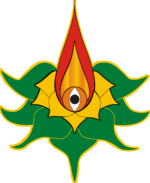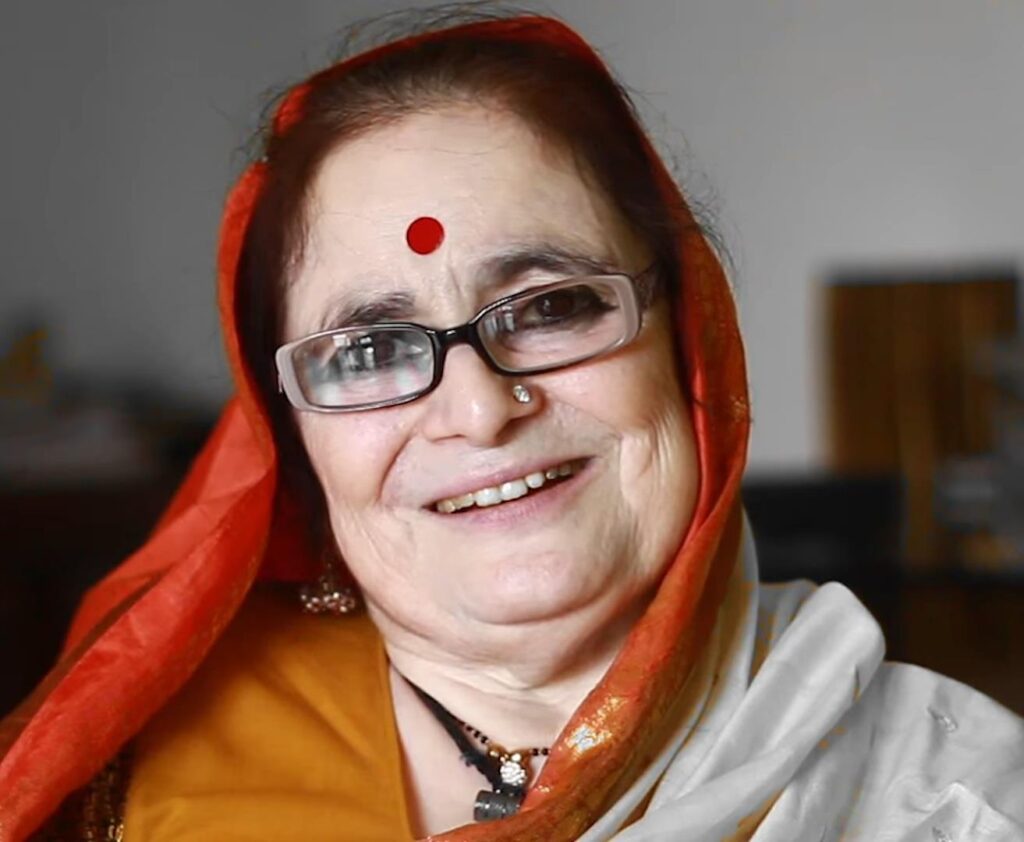This was first published in the print edition of Manushi journal, Issue no. 123.
|
|
Padma Sachdev is a charming, delightful person, full of bubbling liveliness, home-spun fun and laughter (rather loud for more refined ears). She is also a lovable person with the homely qualities of a good housewife, an excellent cook, an entertaining hostess and an interesting talker -hugging attention all the time. She is a successful writer with a wide readership among a certain class. All these mutually supportive elements combined with an irrepressible lust for life, a positive attitude, strong will power, tremendous energy and single-minded commitment to achieve, to carve out a name for herself have enabled her to survive three serious setback to her health, and yet produce a sizeable amount of literature. Writing both in her mother tongue Dogri and the national language Hindi, she has to her credit six collections of Dogri poetry, eight books of Hindi prose including two novels, one collection of short stories, an autobiography, a travelogue and more than half a dozen translations. She also writes an occasional article in Hindi for newspapers and journals. She is quite an achiever with several awards like the Sahitya Akademi Award at the young age of thirty for her first collection of Dogri poetry, Soviet Land Nehru Award, Hindi Academy Puraskar, U.P. Hindi Academy Pruaskar, Raja Ram Mohan Roy Puraskar, Joshua Poetry Award, and the Jammu & Kashmir Government’s Robe of Honour.
Padma was born in Jammu in 1940. Being the eldest of three children of Professor Jai Dev Badu, a Sanskrit scholar who became the victim of India’s Partition in 1947, she started her education in the primary school of her ancestral village Purmandal, situated on the banks of the sacred stream Devaka celebrated in Agni Purana, about 39 km to the north-east of Jammu. She grew up memorising and reciting Sanskrit slokas and Hindi couplets on her father’s knees at the age of four or five, and later, singing Dogri folk songs with local groups of women to the accompaniment of dholak and composing simple verses on the pattern of Dogri folk songs.
While studying in first year college, she became the first poetess of Dogri when she shared the stage with established Dogri poets and recited a song composed by her in a kavi sammelan at Jammu before a large and distinguished audience, including the chief minister of Jammu and Kashmir state. The song was published next morning in a local Urdu paper Sandesh edited by Ved Pal Deep, a prominent Dogri poet, twelve years senior to her. They fell in love with each other and got married against the objections of relatives on both sides. Padma was at the romantic age of 16 then. A few months later she suffered the first bout of her serious illness tuberculosis of the intestines and had to remain in a hospital at Srinagar for about three years. But she had already made a name for herself with her poem Raja Diyan Mandiyan written at the age of 14. It is a remarkable poem from the pen of a girl so young, for its craftsmanship, content, tone and texture. It voices the feelings of the oppressed and the exploited poor, symbolised by an old woman, against the inhumanity and insensitivity of the powerful. The poem has been included in almost all the anthologies of Dogri poetry and occupies an important place in the repertoire of Padma’s works. This poem and seven smaller pieces of her verse appeared in print for the first time in a selection of Dogri poetry of the most promising young poets titled Madhukan published by the J & K Academy of Art, Culture and Languages in 1959. Its editor Prof. Ram Nath Shastri com-mented on her spirit of revolt, courage, sensitivity, intensity of experience and sweetness of language.
After recovery from her illness, Padma retur-ned to Jammu, and worked as a staff artist with Radio Kashmir, Jammu. Soon after, she separated from her husband. This step alienated her from the conservative middle class society of Jammu and she lost her job. With a letter from Bakshi Ghulam Mohammed, the-then Chief Minister of Jammu and Kashmir, addressed to the Director General of All India Radio Delhi, she came to Delhi and got employed as a Dogri newsreader. In due course she got married to a long time friend Surinder Singh, a famous singer of Hindustani classical music.
In 1969 Padma Sachdev published her first collection of poems with an introduction by a stalwart among Hindi poets, Ram Dhari Singh Dinkar. He wrote : "Padma ki kavita sun kar mujhe laga mein apni kalam phaink doon kyoonki jo batein Padma kahati hai, wahi asli kavita hai". (Reading the poems of Padma, I felt I should throw away my pen because the things Padma says is real poetry.) The book got her the Sahitya Academi Award. Thereafter she has published five more collections of her poems at regular intervals Tawi Te Chanhaan in 1976, Nehriyan Galiyan in 1982, Pota Pota Nimbal in 1987, Uttarbaihni in 1992 and Tainthiyaan in 1999. The titles of her books are tell-tale, symbolic and significant. They reflect her predominant moods and concerns of the moment. Meri Kavita, Mere Geet sounds like My Toys, My Dolls with a sense of childlike pride of possessiveness of knick-knacks. The poetic pieces here are soaked in feminine sentiments of a young Dogra girl nostalgic reminiscences of childhood days, anxieties of budding youth, feelings of a girl married far away, desire for motherhood, yearning for and love of the soil, love for Dogri, Dogra way of life and flora and fauna of Duggar.
Tawi Te Chanhaan in two parts contains two type of poems, rhymed and unrhymed, also of two riversone of Dogri feminine sensibility symbolised by the river Tawi, ancient Taushi, Suryaputri, daughter of the sun on whose bank, Jammu is situated and the other, Chenab epitomising male Punjabi consciousness full of vigour and passion, and associated with romantic tales like those of Sohni Mahiwal. Here one notices maturing of love with melancholic shades.
The mood of Nehriyan Galiyaan (Dark Lanes) is one of intro-spection, some disenchantment, irrepressible yearning and also a certain concern for enviro-nment. In Pota Pota Nimbal, the poetess looks at the sky slowly clearing up, the clouds being lifted by the finger-tips of some invisible hand and she looks at the sea with rivers losing their identity and merging with it. There is self-exploration in some of the poems here, revealing the development of a new dimension in her sensibility, a mystic awareness and a certain reaching out to something ‘beyond the sphere of our sorrow’.
In my view, the book contains some of her best poems. There are three types of poems in this collectionone, poems in the romantic mould emerging naturally out of a sensitive feminine sensibility deeply rooted in her native Dogri soil-love and yearning, held taut in silence and suffering, stirring pain and nostalgia for vignettes of Dogra life in the hills of Shivalik, celebration of beauty of nature, all bathed in emotional intensity and etched in memorable imagery. The sea is a surge of tears held in a woman’s eyes, the moon is a silver nose-ring quivering in the sky, the evening is a daughter-in-law with whom the night slowly descending a mountain trail stops to chat with, and midnight is the time when moonlight is held in the embrace of the clouds.
The second category of poems shows the poet’s concern for environment and humanitysnows of the Himalyas, Shiva’s abode covered with drops of red blood and enemies of humanity spreading poisonous particles over the Dal Lake, on the pine needless and in the eyes of Nargis flowers. The poems with a mystic element reveal a yearning for the finite to become infinite, of the drop to become the ocean, a longing to die for a while in the beauty of the evening star, a desire to fill the emptiness within with the splendour of a flaming tree.
Her last two books of poetry Uttarbaihni and Tainthiyan came after she had suffered the second serious setback to her health. They are a mixed bagsome good lines, some weak lines. The quality of her work here seems to have suffered; perhaps her health has had something to do with it or her preoccupation with output in diverse fieldsHindi journalism, Hindi literature, translation and writing in Dogri.
All in All, Padma Sachdev has won a distinct place for herself and for Dogri poetry on the Indian literary scene.


